Rhythms
The music we are using to start our rhythm work is a 4/4. This means it has a marching sound. Most disco music is 4/4.

Look at the music – there is a 4/4 at the beginning.
The notes on the line tell the pianist what sound to make and how long the sound or count should last. There are 4 counts to each bar of 4/4.
The music is divided into bars. There is a line to separate each bar of music. The length of each bar is the same; the notes in each bar have to add up to the same counts of four. Think of each bar like a cake. Each note is a slice of cake. There is only one cake so if there are more notes the slices are smaller.
For dancing, the steps are usually counted up to 8 each time. So that is 2 bars of 4/4. Let’s have a look at the different notes we are using when we start dancing.
Crochet
A crochet is a quarter bar of music.
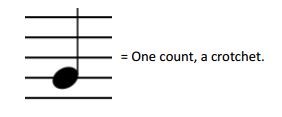
There are 4 quarter notes in one bar of 4/4 music. Below are two bars of 4/4 music with crotchets. The music counts of 4 are at the top of the music, and the dance counts of 8 are at the bottom of the music.

So our cake is divided into 4 equal slices:

- Clap in time with a marching 4/4 piece of music
- March in time to a 4/4 piece of music
- Clap for 4 and March for 4. You are clapping 4 x quarter notes and stepping 4 x quarter notes. This is 8 all together, which are two bars of music.
- Clap for 4 and make a pattern with the 4 steps.
Minims
A minim is a half note.

There are 2 minims in one bar of 4/4 music. A minim lasts for the same amount of time as two crotchets. Below are two bars of 4/4 music with minims. The music counts of 4 are at the top of the music, and the dance counts of 8 are at the bottom of the music.
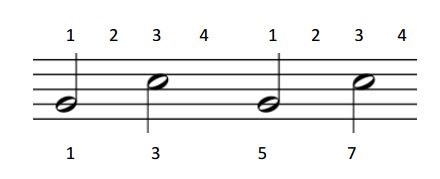
So our cake is divided into 2 equal slices:

- Clap minims (half notes) to a 4/4 marching piece of music
- Clap 2 x half notes (1 bar of music) and step 2 x half notes. You are clapping and stepping 2 bars of music, or 8 counts.
- Clap 4 Crotchets (quarter notes) and 2 minims (half notes)
- Clap and step 4 x quarter notes and the 2 x half notes
Semibreve
A Semibreve is whole note.

There is one whole note on one bar of 4/4 music.
Each whole note lasts for either 4 x quarter notes (crotchets) or 2 x half notes (minims). Here are two bars of 4/4 music with semi breves.
The music counts to 4 are at the top, and the dance counts of 8 are at the bottom. As you can see, in dance we count 1 and 5, but miss the other counts. This is because a semibreve lasts for 4 crotchets or two minims. In dance, we show that by making a clap last for four counts by keeping our hands together.
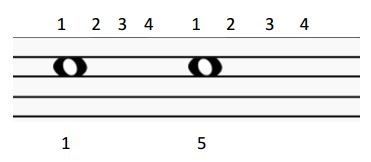
So our cake is just one big piece:

- Clap semibreves (whole notes) to a 4/4 marching piece of music
- Clap 1 x whole notes (1 bar of music) and step 1 x whole notes. You are clapping and stepping 2 bars of music, or 8 counts.
- Clap 4 Crotchets (quarter notes), 2 minims (half notes) and 2 x semibreves (whole notes)
- Clap the above and step it.
Quavers
A quaver is an eight note.

In groups of two the tails are joined up.
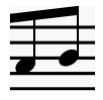
There are eight quaver notes on one bar of 4/4 music. Each lasts for half of a quarter note.
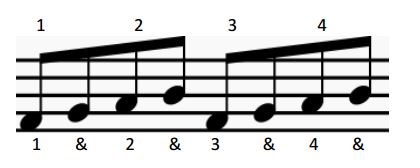
So our cake is divided into 8:
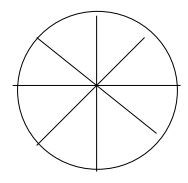
Clap even quavers (eighth notes) to a 4/4 marching piece of music
Clap 8 x even eighth notes (1 bar of music) and step 8 x even eighth notes. You are clapping and stepping 2 bars of music, or 8 counts.
Clap/step 4 x quarter notes, 2 x half notes, 8 x even eighth notes and 1 x whole note = 2 x 8 dance = 4 bars of music.
So the rhythm in Question three looks like this:
1 2 3 4 5 ~ 7 ~ 1 and 2 and 3 and 4 and 5 ~ ~ ~
Accented quavers
Accented eighth notes (quavers)
We count or write them like this:
and 1 and 2 and 3 and 4 and 5 and 6 and 7 and 8
They are accented eighth notes. We put the ‘and’ and the count close together when we count, clap of step. We step them as ball-change steps.
1. Clap accented quavers to a marching 4/4
2. Clap 8x even eighth notes (one bar of music) and 8x accented eighth notes = 2 bars of music
3. Clap/step 4 x quarter notes, 2 x half notes, 8 x accented eighth notes and 1 x hole note.
The rhythm in Question 3 sounds like this:
1 2 3 4 5 ~ 7 ~ and 1 and 2 and 3 and 4 5 ~ ~ ~
To make sure you understand everything, try teaching all the note values to a parent or friend; if they can understand it, then you do!
Develop your work by putting a floor pattern on the steps. Then change the steps. You must count the note values as you do each step. Make sure you can repeat it.
Now put arm lines on your dance steps. Try this 16 count (4 bar) one:
4 x quarter notes
On counts 1 2 3 4 = 4 steps in a square
2 x half notes
On counts 5 and 7 = 1 Side drag to the right, 1 to the left
8 x even eighth notes
On counts 1 and 2 and = 2 runs forward to right on diagonal
On counts 3 and 4 and = 2 runs forward to left on diagonal
1 x whole note
On Count 5 = 1 step backwards taking 3 counts to lower body to the floor.
Then repeat the whole thing, but do accented eighth notes instead of even eighth notes.
Try making up your own 16 count sequences, and make sure you can count them.
Try using different sorts of 4/4 music; different speeds and different styles (jazz, pp, classical piano, orchestral etc).
Note values
All tap examination candidates from and including Grade I need to know the note values of every exercise. This tells you when to “clap” for 1 bar of 4/4 music – 4/4 music is a “marching” tune
Whole note
clap:- 1 - - - = 1 bar
Half note clap:- 1 - 3 - = 1 bar
Quarter note clap:- 1 2 3 4 = 1 bar
Even eighth notes clap:-and 1 and 2 and 3 and 4 = 1 bar
Accented eighth notes clap:- and 1 and 2 and 3 and 4 = 1 bar
Twelfth notes clap:- and a 1 and a 2 and a 3 and a 4 = 1 bar
Set tap rhythms
Primary
and 1 2 3 and 4 5 6 7 and 8
Shuffle ball change, shuffle ball change
Step Step Step ball change
Clap twice. Dance 6 times
Grade I
1 2 3 4 and 5 and 6 and 7 and 8 1 2 3 4 5 and a 6 and 7 – (miss count eight)
Interpretation
and 1 and a 2 Hop step pick – up spring step
and 3 and a 4 Hop step pick – up spring step
and 5 Ball Change
6 Pause
and 7 and 8 Tap step ball change
Clap Twice and Dance Twice
Grade II
and 1 and a 2 and 3 and a 4 and 5 - and 7 and 8 (miss count 6)
Interpretation
and 1 and a 2 Hop step pick – up spring step
and 3 and a 4 Hop step pick – up spring step
and 5 Ball Change
6 Pause
and 7 and 8 Tap step ball change Clap Twice and Dance Twice
Grade III
1 and a 2 and a 3 and a 4 5 and and 7 8
- Clap
- Dance four times – Teacher’s tap arrangement
Grade IV
1 and - and 3 and 4 5 and and a 6 and and a 7 and
- Clap
- Dance four times – Teacher’s tap arrangement
Counting time steps and breaks
Singles
8 and 1 2 and3 and
4 and 5 6 and 7 and
8 and 1 2 and 3 and 5 and 6 and 7
Doubles
8 and 1 and 2 and 3 and
4 and 5 and 6 and 7 and
8 and 1 and 2 and 3 and 4 and 5 and 6 and 7
Triples
8 and 1 and a2 and3 and
4 and 5 and a6 and 7 and
8 and 1 and a2 and 3 and 4 and 5 and 6 and 7
Single time steps
Shuffle (R) hop (L) spring (onto R) tap step (L fed) step (R)
8 and 1 2 and 3 and
Shuffle (L) hop (R) spring (onto L) tap step (R fwd) Step (L)
4 and 5 6 and 7 and
Shuffle (R) hop (L) spring (onto R)
8 and 1 2
Shuffle step (L) shuffle step (R)
and 3 and 4 and 5
Shuffle (L) ball change (L.R.)
and 6 and 7
Double time steps
Shuffle hop tap spring tap step step
8 and 1 and 2 and 3 and
Shuffle hop tap spring tap step step
4 and 5 and 6 and 7 and
Shuffle hop tap spring
8 and 1 and 2
Shuffle step shuffle step
and 3 and 4 and 5
Shuffle ball change
and 6 and 7
Triple time steps
Shuffle hop shuffle spring tap step step
8 and 1 and a 2 and 3 and
Shuffle hop shuffle spring tap step step
4 and 5 and a6 and 7 and
Shuffle hop shuffle spring
8 and 1 and a 2
Shuffle step shuffle step
and 3 and 4 and 5
Shuffle ball change
and 6 and 7
